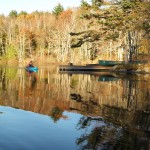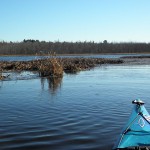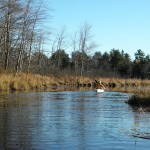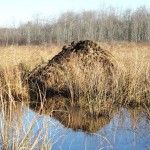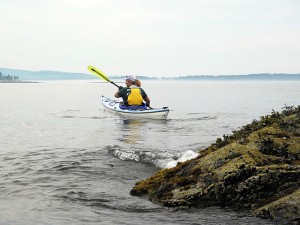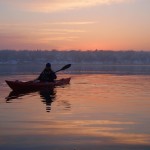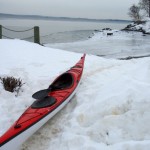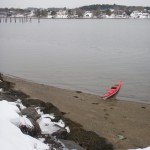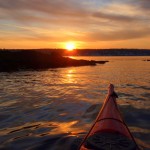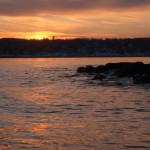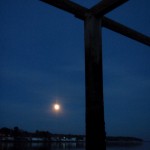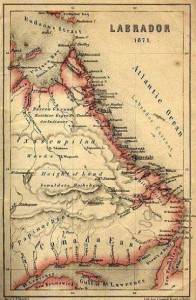Slalom, a race over a winding or zigzag course, isn’t just for skiers anymore. Canoers and kayakers get to slalom too. And they did — last Sunday in the annual slalom races at the Kenduskeag Stream Park in Bangor.
Below the Harlow Street Bridge in Bangor, the Kenduskeag Stream enters a picturesque steep-sided valley. Between the bridge and and the Shopping Cart Drop, the stream is narrow, the currents are strong; and there are two Class II-III drops — drops that have claimed more than a few boats during the 16-mile Kenduskeag Stream Canoe Race. For the downriver racer, the goal is to keep your boat upright, keep your bow downstream, have the right line and cruise right through this area, spending as little time as possible in it, never looking back.
Last weekend’s slalom race brought a whole new perspective to this part of the river, as the slalom required us to go sideways to the current, turn our bows into the biggest waves, reverse direction and go back upstream, take the drops at an angle and eddy out below, and even negotiate some of it going backward.
A good slalom racer, as I was to find, needs endurance to paddle hard for 3 minutes, power to turn a boat and accelerate upriver against the current, and the chutzpah to pull off tricky maneuvers in moving water. More than anything, slalom racing requires boat control and precise paddle strokes. As with many sports, those who are good at it make it look easy.
It’s not easy, however. Even for those with a lot of experience in other genres of paddling. On Saturday, the day before the competition, after getting some tips and little coaching from experienced slalom paddlers, I took my first run at the quarter mile slalom course. The first gate was straight across the river from the starting point and below a drop. Because of the strong current, I wasn’t sure if I could get there without embarrassing myself, so I skipped it, telling myself I’d work on that one on my next run. Gate number 2 looked easy enough, but slightly submerged rocks immediately upstream of the gate blocked my intended line. I missed it. Gate 3 had some really fast current going through it — I made it through cleanly. That gate, however, was offset from Gate 4 which was only eight feet downstream. The current swept me slightly sideways and I battered the pole with my helmet. A 50 second penalty during a race. Gates 5 and 6 were relatively easy and I passed through them cleanly, building up speed as I went. Gate 7, an upstream gate, was far over on river right and above a drop. I approached it too fast, swung far too far past it, and then had to work really hard to get back upstream. Gate 8, another upstream gate, was below the drop. Again, I was moving too fast and settled for just making it through the drop. I skipped it. I was not yet halfway through the course. There were still another eleven more gates to go. You get the idea.
With an afternoon of practice, I was able to at least attempt most of the gates. By race time, the next morning, I was able to get through most of the gates most of the time, but I didn’t always get through cleanly, and it wasn’t always pretty. Meanwhile, more experienced slalom racers in both kayaks and canoes carved their way through the gates with precision and style, never seeming to hurry, never seeming to lose control.
Slalom, then, is a mental challenge as well as a physical one. From what I can see, slalom requires linking the gates and linking strokes. In other words, you need to go through each gate already lined up for the next few gates. If you don’t think about the next gate until after you’ve completed the previous one, it’s too late. The current will carry you downstream and you will miss it. Thinking several moves ahead and initiating moves early is key.
Slalom is a specialized sport with a relatively small following. This is a shame. One of the best parts of slalom is the camaraderie among the participants — some of whom travel throughout New England to participate in the slalom series. The atmosphere among participants is friendly and very welcoming. The difficulty level for these regional races, while challenging, is not overwhelming for intermediate paddlers.
Even if you never get serious about it and join the circuit, slalom is bound to make you a better paddler. Many aspects of river and ocean paddling get easier once you’ve practiced getting through narrow gates. Slalom is also an Olympic sport, one I will take new interest in and pay more attention to, now that I have taken a crack at it myself.
Resources:
New England Slalom Series (official website)
Maine Canoe & Kayak Racing Association
WhitewaterSlalom.us
Canoe Slalom Technique Library
